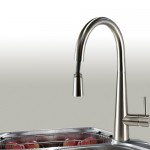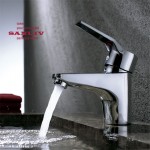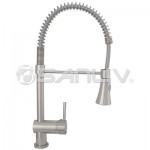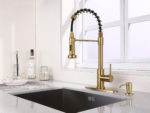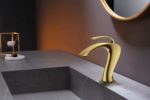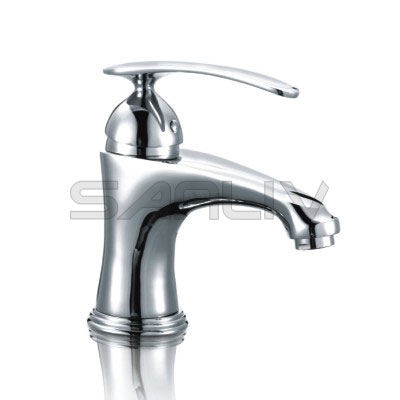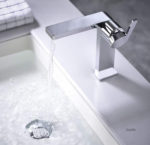How To Clean A Brushed Nickel Faucet? With EasyOff and Sandpaper! Err.. No. I know it’s tempting, especially with those hard-water deposits. White gunk so calcified it might look like a excavated fossil, not your bathroom sink faucet. Or just all splotchy with finger and smudge-marks… Why does brushed nickel show that so much? Yech.
What to use?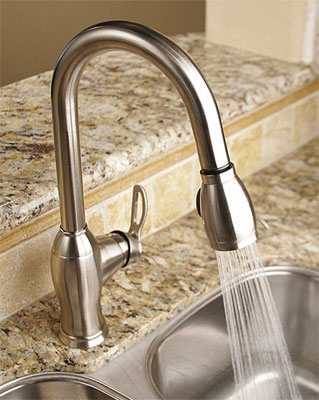
#1 – Avoid anything that you would use on the floor or oven. If you have to get decked like you are going to be conducting chemical warefare with rubber gloves and a face-mask, you’re sure to ruin the nice finish (not to mention the warranty). Also, some basin/tub cleaners are caustic or acid/ammonia-based, and can harm brushed nickel (read the bottom of this post for more).
#2 – Try a simple soap (dish-soap), a clean rag (not from the work-shop please) and water. These are usually soft enough to remove finger-smudge marks, which Brushed Nickel is most prone to. Avoid using scented hand-soaps as these might leave additives or have things like scrubbing-grit.
#3 – The drain parts of a faucet (called the pop up waste or pop-up drain) that have matching trim also often need to be cleaned. Since these usually has water deposits, softer cleaners like Bon-Ami, Barkeeper’s Friend, Zud or Soft Scrub might be good. Again – beware of anything that is made for harder substances like tile or flooring.
#4 – Do not use scratch-pad sponges like Brillo or steel wool. These can take almost anything off of steel, but can take the finish patina or protectants – even the nickel, off the faucet. Soft cloth please!
Why be so careful?
I’m glad you asked! Most often decent big-brand faucets (like Moen, Delta, Price Pfister, Sanliv, Kohler) have “Lifetime” warranties on the faucet’s finish and function. They will cover if the finish suddenly starts peeling, but only if a corrosive substance isn’t involved (Ooops, I used Liquid Plumber on the pop-up drain – not covered). Using those will void that, and admittedly, most DO have a pretty decent warranty department. Delta Faucet was one I dealt with frequently and they had a fast response.
So, there is the warranty to consider, but also the finish itself. Each brand has it’s own special finish that they tout will last for “all-time”. Delta’s is called “Brilliance“, Kohler is “Vibrant“, Moen’s “LifeShine“, and Price Pfister’s “Pforever Pfinish” (they like “Pf’s” – sorry, I’d link that one too, but their site doesn’t have the info).
What it comes down to, is most of these have a cool PVD finish, which is Physical Vapor Deposition. This is technobabble for the finish was put on atom by atom (ya, thats a tight bond). Chances are it won’t PEEL (or crack, chip, etc). But it might tarnish, fade, etc. Most of these have a simple seal on them to protect against all the abuse that comes about on a bathroom sink. Those harsh chemicals can take off that off that protective layer.
Faucets that have a vintage or or old-world look or finish be warned – These might have a “living finish”. They are supposed to tarnish, patina, mottle or fade due to air/moisture exposure. So cleaning them may take them back to the original base metal, but that may be up to you and you’re preferences.
Lastly, be careful of the internal parts. Soaking the faucet with rubber or plastic corrosive chemicals can break down pieces that keep the faucet from going BLOOEY. This includes the crunchy bits like seats (o-rings), valves, or even some basic silicone that may have been used for lubricant for smooth movement (I can’t use a pun here that wouldn’t get me in trouble).
So, you need to clean your faucet. What do you do? WHAT DO YOU DO? If you have the instruction manual (yeah, right), that almost always has a “Care and Maintainence” section. Failing that, most manufacturers have websites that have the info posted. What it comes down to is you can use simple soap and water, but if you use something harsher beware of not damaging the finish, warranty and/or internal parts.
Update (9/29/08)
With the recent comments, I am updating this post with more info on specific cleaners to avoid, and things you can look for to see if that cleaner is safe. NOTE: As most cleansers can change their formula, it’s hard to say “just use this!” so I’ll try to stick to those things that don’t really change, like white vinegar.
Chemicals/Cleansers to avoid using on Brushed Nickel: Delta Faucet states in their FAQ to avoid abrasives and polishes, including bleach-based cleansers. They specifically state to avoid Scrubbing Bubbles, Lysol Basin Tub, Soft Scrub and Tile Cleaner (avoid on the brushed nickel – it probably works just fine on tile/tubs/sinks). Beware product that say they “remove rust or tarnish” – those containing hydrofluoric, hydrochloric and/or phosphoric acids, anything with caustic agents (usually mentioned in the warning sections of the product).
Kohler mentions to avoid anything with ammonia, bleach or acid. Kohler also suggests considering Windex Original (has “Ammonia-D”?), Fantastic Antibacterial Heavy Duty (avoid the Bleach version!), Comet Bathroom Cleaner (Comet has citric acid – 6%).
Moen doesn’t suggest anything specific other than 50/50 of white vinegar and water, and a soft cloth.
If I did not mention it before – never use a “Brillo” or other scratch-pad sponge. It’ll get burnt stuff off the bottom of a pan and will remove any protectant if not the actual nickel off the faucet.

